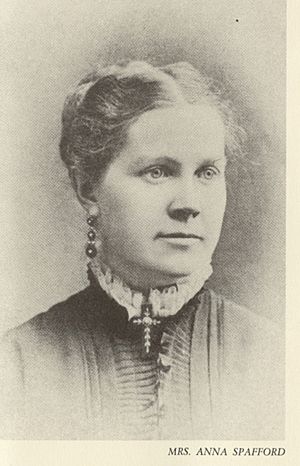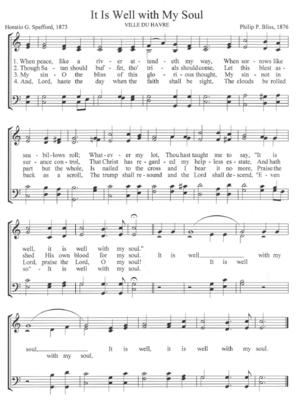Horatio Spafford facts for kids
Horatio Gates Spafford (born October 20, 1828) was an American lawyer. He is best known for writing the Christian hymn It Is Well with My Soul. He wrote this famous song after a terrible family tragedy. His four daughters died when their ship sank during a trip across the ocean. Horatio Spafford passed away on September 25, 1888, in Jerusalem.
Contents
Horatio Spafford's Early Life
Horatio Spafford was born in Troy, New York. His father was also named Horatio Gates Spafford. In 1861, Horatio married Anna Larsen in Chicago. Anna was from Stavanger, Norway. Horatio was a very successful lawyer. He was a senior partner in a large law firm. The Spaffords were good friends with a well-known speaker named Dwight L. Moody.
The Great Chicago Fire
In 1871, Horatio Spafford invested in land north of Chicago. But in October of that same year, a huge fire broke out. This event was called the Great Chicago Fire. The fire destroyed much of the city. It also ruined most of Horatio's investments. He lost a lot of money because of the fire.
A Sad Journey Across the Ocean
Two years after the Chicago fire, the Spafford family planned a trip. They wanted to visit England. Horatio's friend, D. L. Moody, was going to be speaking there. Horatio had to stay in Chicago for business. So, his wife, Anna, and their four daughters went without him.
On November 22, 1873, their ship, the S.S. Ville du Havre, was crossing the Atlantic Ocean. The ship was hit by another vessel. This terrible accident caused the ship to sink. Many people died, including 226 passengers. Sadly, all four of Horatio's daughters were among those who died. Their names were Annie (age 12), Maggie (age 7), Bessie (age 4), and an 18-month-old baby. Horatio's wife, Anna, survived the tragedy.
When Anna arrived in Cardiff, Wales, she sent a telegram to Horatio. It simply said, "Saved alone." Horatio then traveled to meet his grieving wife. As his ship passed near where his daughters had died, he was inspired. He began to write the words to the hymn It Is Well with My Soul.
The Hymn: It Is Well with My Soul
The hymn It Is Well with My Soul is very famous. The music for the hymn was written by Philip Bliss. He named the tune "Ville du Havre" after the ship where the tragedy happened. The original song had four verses. Later, another verse was added.
When peace, like a river, attendeth my way,
When sorrows like sea billows roll;
Whatever my lot, Thou hast taught me to say,
It is well, it is well with my soul.
(Refrain:) It is well (it is well),
with my soul (with my soul),
It is well, it is well with my soul.
Though Satan should buffet, though trials should come,
Let this blest assurance control,
That Christ hath regarded my helpless estate,
And hath shed His own blood for my soul.
(Refrain)
My sin, oh the bliss of this glorious thought!
My sin, not in part but the whole,
Is nailed to His cross, and I bear it no more,
Praise the Lord, praise the Lord, O my soul!
(Refrain)
For me, be it Christ, be it Christ hence to live:
If Jordan above me shall roll,
No pain shall be mine, for in death as in life
Thou wilt whisper Thy peace to my soul.
(Refrain)
And Lord haste the day, when the faith shall be sight,
The clouds be rolled back as a scroll;
The trump shall resound, and the Lord shall descend,
Even so, it is well with my soul.
(Refrain)
Later Years and the American Colony
After the ship tragedy, Anna gave birth to three more children. Their son, Horatio Goertner, was born in 1877. Sadly, he died at age three from scarlet fever in 1880. This was another great sadness for the Spaffords.
In 1881, Horatio and Anna Spafford moved to Jerusalem. They went with a group of people to start a community. This community became known as the American Colony. The people in the Colony helped everyone in Jerusalem. They helped Muslim, Jewish, and Christian people. They offered help without trying to change anyone's religion. They ran soup kitchens and helped those in need.
In Jerusalem, Horatio and Anna adopted a teenager named Jacob Eliahu. Jacob later discovered the Siloam inscription, an important ancient writing.
Horatio Spafford's Death
Horatio Spafford died from malaria on September 25, 1888. He was buried in the Mount Zion Cemetery in Jerusalem.
Legacy of the American Colony
The American Colony continued its good work after Horatio's death. During and after World War I, the Colony helped many people. They provided food, hospital care, and homes for orphans. They supported all communities in Jerusalem, regardless of their background.




